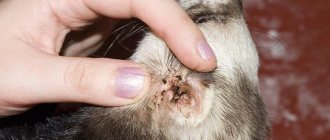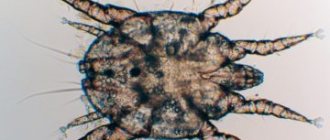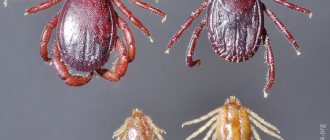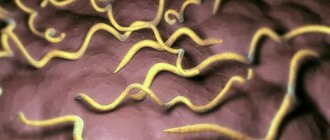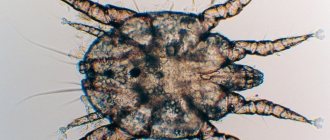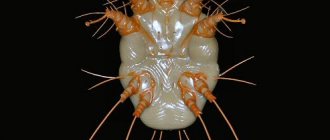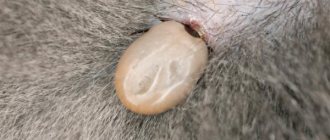Several types of mites can parasitize dogs: sarcoptoid mites (also known as scabies), Demodex Canis, which specializes exclusively on canids, as well as representatives of the ixodid family. It was the latter that got the name “dog tick”. But, despite the classification, not only pets, but also other animals and people become victims of the parasite.
Where does it live?
The dog tick is an arachnid. Latin name: Ixodes ricinus. This is a typical representative of the large Ixodid family. Also called European forest.
Parasites live in Europe, Asia, North Africa and North America. In Russia, they are widespread in the central zone, where they coexist with a related species - taiga ticks. However, warm winters are gradually expanding the distribution boundaries of Ixodes ricinus in northern latitudes.
Arachnids prefer damp areas where they can find a food source. Therefore, they are predominantly localized in mixed and deciduous forests, forest-steppes, meadows, lowlands, and near water bodies. But when there is a lack of food supply, they migrate to drier habitats. They comfortably tolerate ambient temperatures up to 30–35 °C.
Contrary to popular belief, dog ticks, like other representatives of ixods, do not live in trees and do not climb to great heights. They mainly live in grass, where it is more humid.
How do ticks attach to a dog?
There is a myth that ticks climb trees (for some reason they especially love birch trees) and from there jump on their victims. This is fundamentally wrong. Why would a small tick climb a huge tree and waste its time and energy? What if he misses his jump? Ticks are excellent at clinging to dogs from the ground - they climb onto a blade of grass (much easier than on a birch tree), spread their front legs with hooks and cling to all living things that rush past them.
Next, using special receptors, the parasites climb the victim’s fur to the skin and dig into it. In thick fur it is not always possible to notice an uninvited guest. Ticks also love secluded places - the armpits, jaws, ears, chin of a dog, and can even attach themselves to the mucous membrane of the palate or genitals.
Appearance
The description of dog ticks has much in common with other species of the ixodid family:
- hungry adults cannot boast of large dimensions. The size of females does not exceed 4 mm. Males are quite small - barely reaching 2.5 mm in length. The size of hungry nymphs is 1.3–1.5 mm. After saturation with blood, individuals increase in size by 2–3 times and outwardly look like balls. The length of well-fed females varies in the range of 11–13 mm. The photo clearly shows the differences in appearance before and after blood sucking;
- The color of arachnids also depends on the degree of satiety and age. Hungry parasites are brown. After a meal they become gray;
- The body is oval in shape, covered on the outside with a brown shield that reliably protects from external negative factors and injuries from a fall. In males it practically covers the entire dorsal part, in females it barely covers the front. The remaining integument is soft, elastic, with a large number of folds, which provides good stretching and a significant increase in the volume of the body;
- Adult ticks have 4 pairs of thin limbs equipped with growths that help the parasite crawl unhindered on various surfaces. It is by the number of legs that you can distinguish a tick from an insect. The latter has only 3 pairs;
- the head is small, devoid of mustache and full eyes. If you examine the structure of the oral apparatus under a microscope, you will notice chelicerae and protrusions on the oral proboscis, which ensure a strong fixation of the parasite while sucking blood on its victim.
Features of life
On average, the development of a dog tick from egg to adult lasts 2–3 years. During this period, it changes three owners. Under unfavorable conditions, the life cycle extends for 6 years.
With the onset of heat, pests leave their shelters, most often the peak of activity occurs in May-June, August-September. Females are oviparous. To lay eggs, the female must receive a portion of blood. The younger generation also needs nutrition to move to the next stage of development.
They prefer to hunt in the morning and evening, when the plants are wet with dew. Ticks do not jump or fly. They wait for their prey on the grass. Thanks to a well-developed sense of smell and thermoreceptors, a potential host can be sensed at a distance of 10–15 m.
Adults prefer large mammals:
- canids;
- horses;
- goats;
- cows, deer.
The larvae feed on smaller creatures: squirrels, voles. Nymphs choose large rodents, rabbits, foxes, birds, and wild boars. Having chosen a food source, the dog tick spends half an hour looking for a place to attach itself. The parasite's saliva has an anesthetic effect, so the victim does not feel anything. The female’s blood-sucking process can last from 1 to 5 days; young individuals feed for 1–3 days.
A dog tick can also bite a person if he does not feel the bloodsucker’s movements throughout the body.
Natural habitat of parasites
Dog ticks prefer habitats with abundant vegetation where they can easily maintain high humidity, such as deciduous forests. And also where the microclimate and quality of host populations are suitable for the development of all four life stages of the parasite. The dog tick also prefers pastures, heaths, rough grass, city parks, deciduous and mixed forests.
Environmental criteria
As noted above, the dog tick is sensitive to climatic conditions, especially relative humidity, so it requires a habitat with a good layer of moist litter and soil. A prerequisite is that this environment remains moist throughout the day.
Milder winters in warmer climates encourage earlier quests. Hot summers can cause life cycle stages to progress faster. Additionally, a longer growing season may benefit mite populations.
Geographical distribution
Dog ticks cover a wide geographic range, including Scandinavia, the British Isles, Central Europe, France, Spain, Italy, the Balkans, Eastern Europe, North Africa and Russia.
The distribution has changed in a number of countries in recent years. The parasite began to be found at high altitudes in Bosnia and Herzegovina, the Czech Republic. These changes in distribution are the result of a combination of factors, including climate change, land use, and changes in deer and wild boar populations.
Data modeling suggests that the dog tick will later appear throughout Norway, Finland and Sweden as early as 2071-2100. And given the fact that deciduous forests are spreading to the north, the parasite will soon be found in Finland and Norway. Such information will certainly be of interest to tourists and travelers.
Dog ticks are disease carriers
This species is involved in the transmission of a wide variety of pathogens of medical and veterinary importance, including Lyme borreliosis, tick-borne encephalitis virus, human granulocytic ehrlichiosis, tularemia, other rickettsioses, and babesiosis (pyroplasmosis).
Reproduction
Mating of dog ticks occurs on the body of the victim. Males feed for a short time, 20–30 minutes, and after fertilization of the female, they soon die. The satiated female falls to the ground and after a few days begins to lay eggs in moist soil, foliage, and forest litter. Fertility amounts to several thousand. But most of the embryos die.
The development of the eggs lasts about 3 weeks, after which small larvae up to 1 mm in length appear. Juveniles have only 3 pairs of walking legs. The larval stage lasts from 1 to 6 weeks. After feeding, the larvae molt and turn into nymphs, which outwardly look like adult ticks, but are not yet capable of reproduction. To transition to the adult stage, nymphs also need nutrition.
The danger of dog ticks
Even at the larval and nymphal stages, the arachnid becomes infected with viruses from its hosts. Parasites do not show particular selectivity regarding their food source. About 100 species of animals and people can become their victims. For humans, dog ticks are dangerous because they are carriers of encephalitis and borreliosis (Lyme disease). The initial clinical picture of both diseases is similar to the manifestations of ARVI and influenza:
- there is an increase in temperature;
- feverish condition;
- muscle and joint pain.
Borreliosis is a very common tick-borne disease. In most patients, a ring erythema forms in the area where the parasite bit.
Then the disease goes into remission, and upon completion it takes on a more severe form. The consequences of borreliosis can be skin atrophy, deforming arthritis. Encephalitis is fraught with persistent neurological complications and death.
Dog ticks can infect animals with babesiosis, pasture fever, Staphylococcus aureus, borreliosis, and encephalitis, which, in turn, can lead to the death of pets.
Signs of a tick bite and dog behavior
Below are the most characteristic signs of behavior of an animal that has been bitten by a tick:
- In mild cases, the skin at the site of the bite may be red, itchy, and itchy. She's hot to the touch. Ulcers and pustules may form at the site of the bite. The dog refuses to eat, is lethargic, shows anxiety, and sleeps poorly. Her urine has a brownish tint, often mixed with blood.
- In more severe situations, after a parasite bite, the dog’s temperature rises. Inflammation of the joints and disturbances in the functioning of the heart may occur. The animal loses weight, pus and blood are discharged from its nose and eyes. Sometimes the dog suffers from pulmonary edema and inflammation of the brain.
How to protect yourself from ticks
Dogs and cats, due to their small size, are ideal victims for dog ticks. Parasites most often bite unprotected pets in the abdomen, ear, withers, and neck. Prevention of tick bites in dogs and pets comes down to wearing protective accessories and using acaricidal agents:
- drops on the withers. Veterinary pharmacies offer a wide range of drops for dogs and cats of different ages and weights. The drug protects not only against ticks, but also against fleas. It is enough to treat the animal’s withers once, and it will be protected for several weeks;
- sprays The animal is processed outside. The effect of the spray lasts for several days.
Vaccination for dogs is a radical and effective remedy, but does not provide a 100% guarantee. It does not protect against tick bites, but if an arachnid infects an animal, the disease will be mild.
Protective measures for humans:
- wear closed clothes, trousers tucked into socks. It is preferable to choose a wardrobe in light colors so that a crawling tick can be easily seen;
- use acaricidal agents to treat clothing, tents, forest parking areas, summer cottages and home areas;
- If the region has an unfavorable epidemiological situation regarding tick-borne encephalitis, vaccination is recommended. There are no vaccinations against borreliosis.
Are ticks on a dog dangerous for humans?
Ticks that cause piroplasmosis in dogs can cause the same disease in humans.
The ixodid tick itself is not dangerous. It only carries Babesia parasites, which enter the blood of an animal or person through its salivary glands. Moreover, two types of arthropods are dangerous for people, and one species is dangerous for animals. Microorganisms then multiply in the blood and infect red blood cells.
Its waste products are toxic and poison the human body. When an infected person's red blood cells are destroyed, anemia occurs. The patient feels tired for no reason, his performance is noticeably reduced, and his hemoglobin decreases. Dead blood cells clog the kidneys. In this case, the patient suffers from kidney failure.
In ninety-nine cases out of a hundred, people infected with AIDS are at risk of getting sick after a tick bite. Also at risk are those who have undergone surgery on the spleen. Healthy representatives of humanity are less susceptible to this disease.
Important! Precautions must be taken when removing a tick from a pet's fur. If you are careless, infection can occur if the parasite is accidentally crushed and no attention is paid to it.
If, however, the danger could not be avoided, then you can understand whether a person has become infected or not by the following symptoms. In a short period of time, chills appear in the body and aches and pains are tormented. I want to sleep, and there is general apathy. Tablets and mixtures hardly help. Sometimes vomiting and diarrhea occur.
Read in detail about the symptoms of tick-borne encephalitis in humans.
Reference. In most cases, arthropods do not cause harm to humans. But it is important to remember that they are carriers of various diseases dangerous to humans: encephalitis, typhoid, plague.
To prevent cases of your pet becoming sick from a tick attack and to develop the necessary precautions, you need to consider which types of arthropods are especially dangerous for dogs and humans. It is important to consider what time of year bloodsuckers are most active. It is also advisable to know how you can help a dog if a parasite gets on its fur, and what to do if it becomes infected.
Actions to take if bitten by a tick
What to do if a tick has attached itself:
- remove the parasite in a medical facility. If this is not possible, remove the tick yourself using a special tool or thread;
- 25% of the tick population are carriers of viruses and infections. Therefore, the extracted arthropod must be submitted to a laboratory for analysis;
- If the tick is infected or you feel unwell, contact an infectious disease specialist. Borreliosis responds well to antibiotic therapy, and tick-borne encephalitis in the initial stage is treated with immunoglobulin.
How to remove a tick
During the warm season, examine your pet daily, even if the dog has been treated for parasites. If you find a tick, do not smear it with oil - this grandfather's method does not work. The tick must be removed. The best way to do this is to use a special tool - a twister. They are sold at any pet store. Every pet owner should have one in their first aid kit. When using tweezers or trying to remove a tick manually, there is a high risk of tearing off and leaving the proboscis in the wound. It is better to avoid this, as inflammation will temporarily develop in this area.
If you doubt your abilities, contact your nearest veterinary clinic. The specialist will remove the tick quickly and without consequences, and at the same time carry out all the necessary tests to exclude infections transmitted by the tick.
